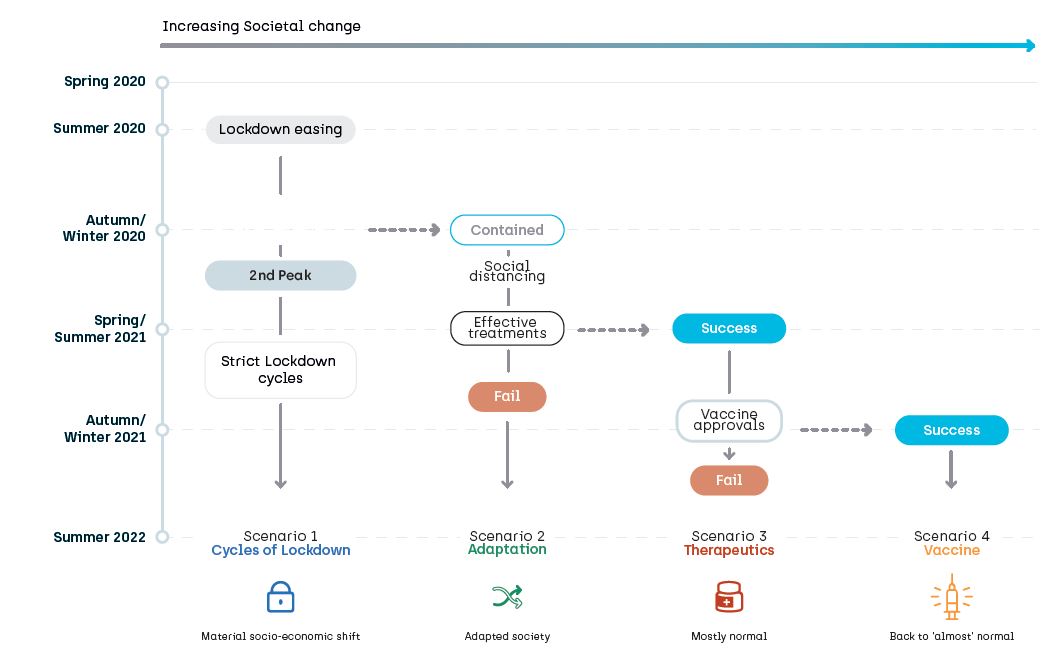In July we asked the question: what will transport look like after the Covid-19 shock. Our view then and now is that the form and timing of any medical resolution of the Covid crisis is the first order uncertainty. We said this would drive the direction of behavioural and policy responses and what this means to the economy, people’s activity and transport demand. Based on this, we identified three key uncertainties:
- whether or not there is a second wave
- whether or not effective treatment pathways are found
- whether or not a successful vaccine is developed and widely deployed
Because forecasting a single definitive outcome is fraught with problems, we went on to set out four scenarios:
- Scenario 1 | Cycles of Lockdown: Social distancing and ‘track-and-trace’ fail to stop a second wave of Covid. Further lockdowns are necessary over the next 2-3 years with the consequent negative effects on society.
- Scenario 2 | Adaptation: No second wave materialises, and society adapts, finding a new equilibrium of behaviours and activities that keep Covid under control.
- Scenario 3 | Therapeutics: By 2021, an effective clinical pathway is found that significantly reduces health impacts and the mortality rate. Society returns mostly to normal.
- Scenario 4 | Vaccine: An effective vaccine is widely deployed in 2022. Society rapidly returns to pre-Covid norms.

Our view in July was that the UK was sitting somewhere between our 'Scenario 1 Cycles of Lockdown' and 'Scenario 2 Adaptation'. As we enter November, England is going back into a lockdown, Wales is in its “firebreak” lockdown, Northern Ireland has been experiencing the strictest restrictions of any of the home nations for a number of weeks, and much of Scotland’s Central Belt is under restrictions. As with elsewhere in Europe, in the UK, Scenario 1 is in the ascendency. As we said in July, new therapeutics and/or an effective vaccine could change the situation quickly. Some new treatments have already been approved, and a number of therapeutics are the subject of ongoing trials. There are 11 vaccines currently in Stage 3 trials, the last step before approval for roll-out.
What does this mean for public transport?
Department for Transport statistics suggest that pre-Saturday’s announcement bus use in England is around 55 to 60% of its pre-Covid levels but was falling. National Rail and London Underground are each between 30 and 35%.
We suggest there are three factors that will determine the future rate of change and scale of public transport use. In order of immediate impact these are:
- Covid regulations and associated guidance: these have led to businesses either being closed or operating in a restricted way. Limits have been placed on the way people socialise and people being asked to continue working from home if they can do so effectively. All of these things reduce the demand for travel. The new lockdown will result in public transport use falling again; non-essential retail will close, those who can work from home are being asked to do so, and the use of public transport is actively discouraged.
- Public transport capacity: the need for social distancing has reduced the capacity of buses, trams and trains to around half their pre-Covid levels. Sooner or later, demand will grow to a level that the capacity of public transport vehicles becomes the principal constraint. There is anecdotal evidence that pre-November lockdown this point may have been reached on some parts of the London bus and rail networks and perhaps elsewhere too.
- Changed behaviour: perhaps the most uncertain and potentially long-term effect, a change in people’s willingness to use public transport. The capacity may be there, but people just don’t want to use the bus, catch a tram or take a train journey. Alternatively, they may choose to continue working from home some or all the time and so commute less, or just travel less for whatever purpose.
